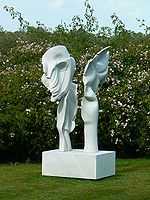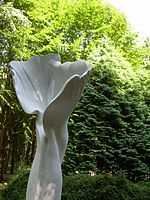Helaine Blumenfeld
Helaine Blumenfeld OBE (born, New York 1942) is an American Sculptor working in Britain and Italy, best known as an artist who has pioneered new methods of carving in stone and for her semi-abstract marble, granite and bronze sculptures which are located around the world as Public art. Her forms are often abstractions of human forms and of elements in nature. She is widely recognized as the most significant sculptor of her generation[1] and "the heir apparent to Moore and Hepworth."[2]
Early career
Blumenfeld grew up on Long Island in New York. She was educated at the University of Michigan and Columbia University, New York, where after a year at Oxford University, she completed a PhD in Philosophy in 1964. When she moved with her husband, Yorick Blumenfeld to Paris, where she did not speak French, she decided to abandon the written word and to study sculpture which she did at the Ecole de la Grande Chaumière (1962–63.) Here her work was noticed by the sculptor Ossip Zadkine with whom she went on to study. In 1966, Blumenfeld had her first exhibition at the Palais Pálffy (Josefsplatz) in Vienna.
In 1973, Blumenfeld, who had recently moved to England, exhibited at Kettle's Yard in Cambridge England. These early sculptures, which were mostly cast in bronze were largely figurative work in the tradition of sculptors such as Constantin Brâncuși, Jacob Epstein, Henri Gaudier-Brzeska, Henry Moore and of course her one time teacher Ossip Zadkine. In 1985, the Alex Rosenberg Gallery in New York showed her sculpture in dialogue with Henry Moore
In 1978, Blumenfeld's first visit to Pietrasanta in Italy marked a turning point in her work as she started carving in marble, mostly at Studio Sem, founded in the 1950s by Sem Ghelardini (1927-1997) who gained international notoriety producing the large scale works of Henry Moore, César Baldaccini, Emile Gilioli, Joan Mirò, Georges Adam and many other celebrated sculptors during the first wave of modern abstract sculpture in the 1960s.
Throughout the 1980s and 1990s Blumenfeld's sculpture, now less clearly figurative but still often of portraying couples and family units in multiple configurations, was exhibited at the Bonino Gallery in New York and in solo and group shows around the world. A member of the Visual Arts Panel of the Arts Council of Great Britain between 1981 and 1988, Blumenfeld was elected a member of the Royal British Society of Sculptors in 1993.
-

Angels: Harmony
-

Spirit of Life (2007)
-
The Chauvinist (Cambridge)
Later career
Blumenfeld's work with the artisans of Pietrasanta led her to evolve a new approach to carving.[3] Learning from an artisan who had devoted a lifetime's work to carving the petals of roses, her work since 1996 is characterized by the way she takes solid, complex units and adds thinner, shell-like elements, which significantly change the mass of each piece: sculptures that had previously seemed earthbound acquire a sense of flight.[4] This may explain why many of her works are multi-layered, the construction of overlapping membranes functioning as a visual metaphor for the fugitive human soul. Recently, Blumenfeld has begun leaving the surface of her clay and plaster models with a more variegated texture where the trace of the artist’s hand survives as testimony to the creative technique. Some of these works have also made their way into bronze, a medium that preserves the imprints of hand on clay.) Only afterwards will she ponder the results for an extended period of time, sometimes over several days, reworking the model until it speaks back to her, confirming its readiness.[5]
The art-historian, Alan Caine, writing for the Woolf Institute in November 2013 describes Helaine Blumenfeld's work in the context of Moore and Hepworth "Take another step away from the direct representation of Henry Moore and Barbara Hepworth and meet Helaine Blumenfeld’s sculptures. They include strong but there is no clear body; no clear head; A title may help: Espirit, Mysteries, Creation or Messenger of the Spirit, but none of these names turns immediately into a visual illustration. Harnessed to the marble or bronze images, we catch sensuous elements – and we discern in most of these works quite detect its borders and attributes. A response seems almost to be erased: overcome by tense, chiselled marks or by a dangerous sharp edge. But still, in almost all of these sculptures, the sense of the human body – and the spirit which inhabits it – seems indelible. This is the language of the eye; not a translation of familiar images into representational objects. This process is, of course, very familiar in music."
Blumenfeld has created over 80 large scale sculptures in bronze, granite, marble and steel in Europe and the United States for private and public clients, including the British Petroleum headquarters in London, the Lincoln Center in New York the Cass Sculpture Foundation at Goodwood and Family (Blumenfeld) at the Henry Reuss Plaza in Milwaukee and The Lancasters at Lancaster Gate in London. At Cambridge University, her sculpture has been commissioned by Clare Hall (Flame, 2004) and Newnham College (Esprit, 2004) as well as public sites around the city, such as at the corner of Brookland’s Avenue and Hills Road (Chauvinist) and at Vision Park, Histon (Shadow Figures.) In 2012 her work was exhibited by the Fitzwilliam Museum along with work by Peter Randall-Page and Kan Yasuda.
Blumenfeld's sculptures feature in many important public and private collections around the world, including those of the Courtauld, Tate, the Smithsonian and Clare Hall, Cambridge. In 2005, a seven-foot, £200,000 Blumenfeld bronze made for a show to commemorate the Holocaust was stolen from a warehouse in south London. It turned up in 2007 just five miles away, chained to a fire escape behind a block of flats.
Blumenfeld has lectured to the Cambridge Visual Arts Society, the Institute of Contemporary Arts, the Pietrasanta symposium and the British psychoanalytic society. In 2003, Blumenfeld received and honorary doctor of letters from Leicester University. In 2004, Blumenfeld was elected vice president of the Royal British Society of Sculptors.
Blumenfeld has served as Vice-President of the Royal Society of British Sculptors from 2004 to 2009. She is the first woman to be awarded the ‘International Sculpture Prize: Pietrasanta and Versilia in the World’ - an honour previously awarded to Marc Quinn and Fernando Botero. Blumenfeld has exhibited internationally and 65 of her large bronze and granite sculptures are in public collections. In 2009 The Financial Times (FT) described Helaine Blumenfeld's work as "the Henry Moores of the Future"[6] Blumenfeld is a life member of Clare Hall, Cambridge University and holds an honorary doctorate from the University of Leicester.
In 2008, the Royal British Society of Sculptors held an exhibition in Blumenfeld's honor and as an American citizen, she was awarded an honorary OBE by Her Majesty, Queen Elizabeth II for services to the arts. Jeremy Hunt, Britain's Minister for Culture, Media and Sports, presented the award at the House of Commons in June 2011.[7] He said, "This acknowledges your remarkable contribution to the arts as one of the boldest and most diverse artists working today. Your pioneering approach has placed you at the forefront of contemporary sculpture. Alongside your work as a sculptor has been your longstanding commitment to the Royal Society of British Sculptors where you were behind the delivery of some of the society's most outstanding projects, helping your sculptor colleagues to showcase their work in every way possible."
In 2013 when Helaine Blumenfeld's monumental piece, Spirit of Life, was installed on London's Park Lane opposite the Dorchester Hotel the Wall Street Journal commented, "One can only imagine that (the critic Richard) Dorment and other objectors to this “festival of expensive tat” will be delighted by the most recent arrival at Park Lane. Spirit of Life is an extraordinary six-ton, wafer thin, white marble piece by acclaimed sculptor, Helaine Blumenfeld."
"There is no escaping the pain and fear which change involves,” says writer Nicola Upson, "but every single piece that Blumenfeld has ever created is in some sense an effort to transform torment into beauty and hope, to visualise Kierkegaards's premise that art- whilst it may begin with a scream- must transform that scream into music." [8]
In 2013 Salisbury Cathedral honored Blumenfeld with a major retrospective. Twenty sculptures were exhibited in the nave, the cloister and on the lawns, inviting visitors and worshippers to encounter them. Writing in Perspectives Magazine [9] the Reverend Dame Sarah Mullally writes of a moment of spiritual awe, "The Cathedral and Helaine Blumenfeld recognise that the spiritual incorporates a search for meaning and purpose, which may include a relationship with an ultimate other such as God, but above all it takes us beyond ourselves."
Family Life
Blumenfeld divides her time between Grantchester, near Cambridge, where she lives with her husband Yorick, a writer, son of photographer Erwin Blumenfeld and Pietrasanta, Italy where she maintains several studios. She has two grown sons, environmentalist Jared Blumenfeld and Television ProducerRemy Blumenfeld.
References
- ↑ (2013) (...http://www.auctioncentralnews.com/index.php/columns-and-international/london-eye/10122-london-eye-june-2013)
- ↑ (January 2013) (...http://www.apollo-magazine.com/homepage/7934308/shaping-the-future.thtml)
- ↑ (2012)(...http://www.independent.co.uk/arts-entertainment/art/features/helaine-blumenfeld-art-is-a-commitment-to-risk-a-reflection-of-life--nothing-stays-the-same-7827250.html)
- ↑ (2010) (...http://www.sculpture.org.uk/HelaineBlumenfeld)
- ↑ (2012) (...http://thesculptureagency.blogspot.co.uk)
- ↑ (January 3rd 2009)
- ↑ (2011)(...http://www.culture.gov.uk/news/news_stories/8316.aspx)
- ↑ http://www.wsimagazine.com/uk/browse-by-continent/europe/united-kingdom/sculpture-brings-beauty_20130725092941.html#.UpKVWLzz1CU
- ↑ (2013)(...http://www.woolf.cam.ac.uk)
Further reading
- " Helaine Blumenfeld. Taking Risks" By Tom Flynn. Hardback catalogue accompanying Taking Risks, a solo exhibition at Robert Bowman Modern (6 May - 25 June 2010)
- "Helaine Blumenfeld" By Karen Wright. illustrated with 231 photographs/
- "Letting Go" By Alan Caine. Catalogue accompanying Letting Go, a solo exhibition at Robert Bowman Modern (6 November 2008 - 23 January 2009).
- "The space within" By Nicola Upson. Catalogue accompanying the space within, a solo exhibition at the Royal British Society of Sculptors, London (7–29 February 2008).
- "Helaine Blumenfeld: Visionary Landscape" By Valentina Fogher. Catalogue accompanying Visionary Landscape, a solo exhibition organised by the Comune of Pietrasanta (from 25 February until 11 March 2007) to mark Blumenfeld's receipt of the 16th edition of the international sculpture prize, "Pietrasanta e la Versilia nel mondo."
- Modern British Sculpture Guy Portelli A comprehensive study of modern sculpture developments in Great Britain through the work of 95 of the most influential and award-winning practitioners from the second half of the 20th century. Published by Shiffer.
- Mythologies: The Sculpture of Helaine Blumenfeld" By Nicola Upson. The first comprehensive exploration of Blumenfeld's work and a uniquely detailed study of her development. Published by Overlook Press.
- "The Sculpture of Helaine Blumenfeld" By Edward Lucie-Smith. The earliest monograph about Blumenfeld's sculpture illustrating the first two decades of her oeuvre.
External links
| Wikimedia Commons has media related to Helaine Blumenfeld. |
- Helaine Blumenfeld
- Biography at artnet.com
- How we met: Helaine Blumenfeld & Michael G Wilson
- http://entertainment.timesonline.co.uk/tol/arts_and_entertainment/visual_arts/article2015876.ece
- Relative Values: Helaine Blumenfeld and her son Remy